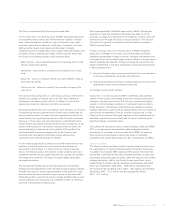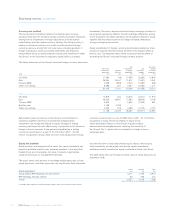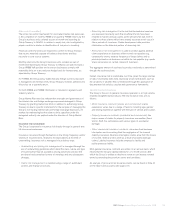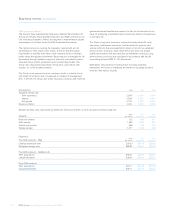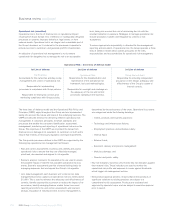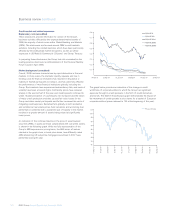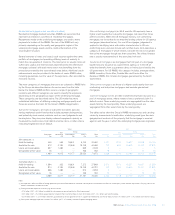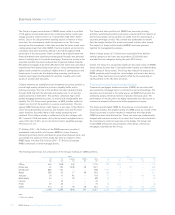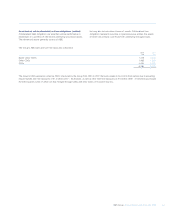RBS 2008 Annual Report Download - page 122
Download and view the complete annual report
Please find page 122 of the 2008 RBS annual report below. You can navigate through the pages in the report by either clicking on the pages listed below, or by using the keyword search tool below to find specific information within the annual report.
121RBS Group Annual Report and Accounts 2008
Other risks (unaudited)
Regulatory risk
Regulatory risk is managed by designing, maintaining and
implementing policies and systems in order to ensure effective
compliance with all regulatory and legal requirements in the jurisdictions
in which the Group operates. The Group’s approach to regulatory risk
has three distinct elements:
•The review of potential changes in regulation to ensure that the Group
addresses the risks arising from such changes and responds
appropriately;
•The monitoring of compliance with existing rules and regulations and
the mitigation of the consequences of any inadvertent non
compliance; and
•The management of effective relationships with regulators to ensure
constructive engagement.
Under a Group-wide framework of high-level policies, the Group and its
subsidiaries engage co-operatively with all regulatory authorities in all
the relevant jurisdictions, whether in response to regulatory change, on-
going supervisory requirements or regulatory investigations.
During the course of 2008, responsibility for policy and oversight of
anti-money laundering, sanctions and counter-terrorist financing moved
to the Group Head of Regulatory Risk & Compliance.
Reputation risk
Reputation is the body of perceptions and opinions held by the
stakeholders of an organisation; customers, suppliers, employees,
investors, interest groups, regulators and government. Reputation
determines how stakeholders are likely to behave towards an
organisation. Reputation risk arises from any activity that could have an
adverse impact on the reputation of the Group. There are several
important drivers of the reputation of a company (and reputation risk)
including: financial performance; corporate governance and quality of
management; ethical, social and environmental performance; marketing,
innovation and customer relationships; and regulatory compliance and
litigation.
The Group protects its reputation by understanding and managing
reputation risks, including failure to meet the expectations of
stakeholders.
The Group will only enter into a commercial transaction or customer
relationship which is legal and complies with regulatory requirements,
has economic substance or business purpose and is not designed or
used for inappropriate accounting or tax purposes. The Group takes
care to understand the issues that matter most to stakeholders, balance
the views of all stakeholders and address them coherently. Risks to the
reputation of the Group are identified, assessed, managed, monitored
and reported. The Group pays particular attention to the reputation risks
associated with the introduction of new products or customer
relationships.
It is the responsibility of the management of all Group companies,
acting through individual business units, to ensure that appropriate
controls and procedures are in place to identify and manage the risks to
the reputation of the Group arising from their activity.
The Board has ultimate responsibility for managing any impact on the
reputation of the Group arising from its operations. However all parts of
the Group take responsibility for reputation management.
Pension risk
The Group is exposed to risk to its defined benefit pension schemes as
assets comprise investment portfolios which are held to meet projected
liabilities to scheme members. Risk arises because returns from these
investments may be less than expected or there may be greater than
expected increases in the estimated value of the schemes’ liabilities. In
such circumstances, the Group could be obliged, or may choose, to
make additional contributions to the schemes.
The largest of the schemes, and the main source of pension obligation
risk, is the RBS Group Pension Fund. In October 2006, this scheme was
closed to new employees.
Risk appetite and investment policy are agreed by the Board of
Trustees with quantitative and qualitative input from the scheme
actuaries and investment advisers. The Board of Trustees also consults
with the Group to obtain its view on the appropriate level of risk within
the pension fund.
The Group maintains an independent review of risk within the Pension
Funds.
GALCO monitors pension obligation risk which is assessed by
estimating the potential funding deficit of the scheme with a twelve
month risk horizon, and with a number of different confidence levels.
Monte Carlo simulations are used, based on assumptions of statistical
distribution of future equity returns, future real and nominal interest
rates, sensitivity of asset and liability values to changes in equity returns
and real and nominal interest rates, the impact of an adverse change in
longevity assumptions and mitigation available to the Group.
The most recent funding valuation was carried out as at 31 March 2007.
This showed the fund to be in surplus, and therefore there was no need
in 2008 for additional payments over and above the regular contributions.
The next funding valuation is scheduled to be carried out as at 31
March 2010.


